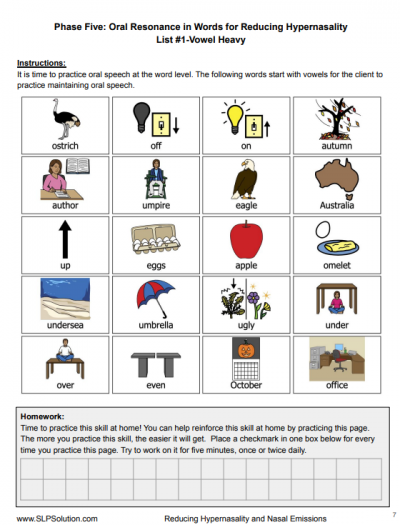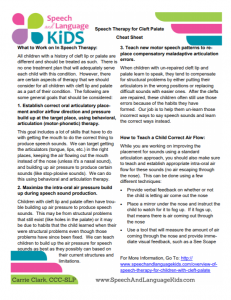Jul 11 2016 30 mins 79
Hypernasality Speech Therapy: Treatment Ideas for Hypernasal Speech
Hypernasality occurs when a child speaks with too much nasal resonance. Airflow tends to be directed up into the nasal cavity during speech instead of primarily through the oral cavity. Nasal emission is when that air comes all the way out through the nose. This can make a puffing or noisy sound in the nose during speech. Here are the steps for therapy for both hypernasality and nasal emission.
Listen to the Podcast on Hypernasality Speech Therapy:
Hypernasality Speech Therapy Goals:
Check out this sample goal for hypernasality speech therapy! Keep in mind, you should modify this goal to meet the needs of each individual client or patient that you’re working with:
The patient will demonstrate appropriate oral and nasal resonance during a 30 minute unstructured conversation in 2 speaking settings with no more than 2 instances of hypernasality.
Therapy Phases for Hypernasality Speech Therapy:
- Refer to ENT: All clients who exhibit voice issues should be referred to an ENT first to check the structures and functions and be cleared for therapy. If hypernasality is present, it may be secondary to a cleft palate and would need to be addressed first.
- Discriminate Between Oral Vs. Hypernasal: The client will be able to discriminate between appropriate oral resonance and hypernasality during speech after listening to a speaker (live or recorded) 85% of the time independently on 3 out of 4 data collection days.
- Technique Practice: After the effective technique has been identified in therapy, the client will practice that technique.
- Oral Resonance in Vowels: The client will use oral resonance when saying vowels 80% of the time with no more than 2 cues on 3 out of 4 data collection days.
- Oral Resonance in Words: The client will use oral resonance in words 80% of the time with no more than 2 cues on 3 out of 4 data collection days.
- Oral Resonance in Phrases : The client will use oral resonance in phrases 80% of the time with no more than 2 cues on 3 out of 4 data collection days
- Oral Resonance in Sentences: The client will use oral resonance in sentences 80% of the time with no more than 2 cues on 3 out of 4 data collection days.
- Oral Resonance when Reading: The client will use oral resonance when reading aloud independently 80% of the time with no more than 2 cues on 3 out of 4 data collection days.
- Oral Resonance in Conversation: The client will independently use oral resonance during conversation in the therapy setting with no more than 2 cues on 3 out of 4 data collection days.
- Generalize Oral Air Flow to Other Environments: Student will use correct oral airflow in a variety of situations and environments.
*** Discontinue Therapy if Not Making Progress: If no progress is made after 6 weeks, client should be re-evaluated by ENT.
Therapy Activities and Techniques for Hypernasality
- Stimulability probe: Try to get the child to imitate oral resonance
- Altering Tongue Position: Try for a lower, posterior tongue placement
- Open Mouth: Have the child speak with his mouth more open
- Change Volume: Try different volumes to see which has less nasality
- Change Pitch: Try different pitches to see which has less nasality
- Auditory Feedback: Teach the child to hear the difference between nasal and oral resonance in himself and others
- Feedback: Tell the child if productions are oral or nasal so he can learn to feel the difference
- Focus on the Facial Mask Area: Have the child draw his focus and attention to the eyes/nose area of his face
- Bio-feedback: Give the child immediate feedback on if air is coming out of the nose like placing a mirror right below nose or using a See Scape

About the Author: Carrie Clark, MA CCC-SLP
Hi, I’m Carrie! I’m a speech-language pathologist from Columbia, Missouri, USA. I’ve worked with children and teenagers of all ages in schools, preschools, and even my own private practice. I love digging through the research on speech and language topics and breaking it down into step-by-step plans for my followers.
Connect with Me:
The post Hypernasality Speech Therapy: Treatment Activities appeared first on Speech And Language Kids.

